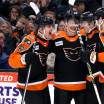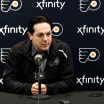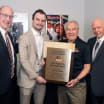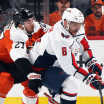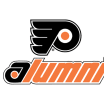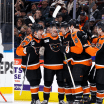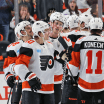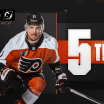The National Hockey League offseason has reached a slowdown period in terms of teams making free agent signings and trades. Clubs are now in a wait-and-see mode to strategize how to handle their remaining cap space (or, in some cases, ways to become cap compliant). Leaguewide, clubs are awaiting resolution on the timing of training camps, the setting of a regular season format and venues, the scheduling of both preseason and regular season games, determinations on the timing of an American Hockey League 2020-21 season and the handling of prospects within the farm system. All of these issues are fluid and subject to change. However, the NHL has set a Jan. 1 target date to begin next season.
Offseason: 3 Ongoing Stories to Follow
Here are three ongoing Flyers storylines that merit watching as the offseason continues
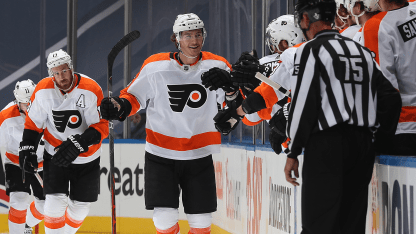
In the meantime, Philadelphia Flyers general manager Chuck Fletcher said last week that he is not "finished" in seeking ways to upgrade the roster before next season but, if no viable opportunities arise in terms of both player fit and salary cap management, he is comfortable going into training camp and the season with the current in-house options and then evaluating the team's needs during the campaign.
"We're still actively talking to teams and agents to see what may be out there. We do have a little bit of cap space left," Fletcher said on Oct. 16. "We can certainly start the year the way we are now, but if there's a way to improve our team, we'll continue to look at ways."
Here are three ongoing Flyers storylines that merit watching as the offseason continues:
1. Getting Myers re-signed
The Flyers currently have roughly $4.8 million of space left under the NHL salary cap ceiling. The team has one remaining internal free agent who remains unsigned: restricted free agent defenseman Philippe Myers.
The player, who was officially an NHL rookie in 2019-20 because he fell below the NHL career games threshold, had a promising season in the final year of his entry-level deal. He projects to play an expanded role on the team's blueline in 2020-21, especially if the Flyers make no further additions to the right side of their defense corps following the retirement of Matt Niskanen.
With Myers, it is not a question of whether he will be re-signed. He is not arbitration-eligible and the odds are slim of another NHL team attempting to sign him an offer sheet. Thus, the question is when the deal will get done, what the average annual value (AAV) of the contract will be and, for how many years will the contract run.
Last off-season, the Flyers re-signed first-time RFA defenseman Travis Sanheim to a two-year "bridge" deal ($3.25 AAV). Sanheim can become an arbitration-eligible RFA after the 2020-21 season. Will Myers also sign a bridge deal, or will the Flyers secure his services on a longer-term contract.
The advantage of a bridge deal, to a team, is that it typically carries a significantly lower AAV than a long-term deal and compels the player to earn such an extension. The disadvantage from a team standpoint is the lack of long-term cost certainty. As long as the player performs to expectations, a subsequent long-term deal inevitably carries a higher cost than it would have if the deal had been made as a first-time restricted free agent.
From a player standpoint, a bridge deal is essentially a bet on oneself that his next deal will be more lucrative than opting for a longer-term option during the first negotiational go-around. The disadvantage is giving up on some longer-term contract security (especially in a flat-cap marketplace) in the event of injuries or a performance flat-line or downturn.
2. Further addressing "Niskanen vacancy".
When the Flyers acquired Matt Niskanen last year, they brought in a player who checked off a lot of boxes: minutes-eating right-handed defenseman, a player used to being matched up against other teams' top lines, an all-situations player who could play both atop a penalty killing rotation and on the second power play unit, a calming veteran presence on the bench and the locker room, and a player with a Stanley Cup ring in his semi-recent past.
Niskanen's retirement with one year remaining on his contract suddenly opened a significant hole on the Philadelphia blueline; a gap that would be hard to fill by virtue of a single roster addition. There was only one player on the unrestricted free agent market who could have checked off all the same boxes and then some -- 30-year-old now-former St. Louis Blues standout Alex Pietrangelo -- but that player was eager to sign with the Vegas Golden Knights and had a very limited "short-list" of alternative destinations he'd consider, along with commanding an extremely high price-tag on the open market (seven-year contract, $8.8 million AAV). Thus, Pietrangelo was able to handpick his destination and name his price even without stoking a bidding war.
Since Pietrangelo-to-Philly was not going to happen, the Flyers had to find other ways to formulate a plan for the post-Niskanen blueline.
One step was to re-sign unrestricted free agent Justin Braun to a two-year contract (in which the veteran player accepted a $2 million AAV cut from $3.8 million on his old contract to $1.8 million on the new one). Braun will continue to be a penalty killing mainstay. At five-on-five, the right-hander may be reunited with Sanheim or he could continue to play right defense on the third pairing, as he did for most of the second half of last season.
To address the loss of a 20-minute defenseman and power play regular, Fletcher signed unrestricted free agent defenseman Erik Gustafsson, a 17-goal and 60-point player for Chicago in 2018-19, to a one-year contract for $3 million.
The left-handed Gustafsson is not a "full" replacement for Niskanen's minutes, although he could fully replace Niskanen's offensive totals. Niskanen was more well-rounded while Gustafsson is more of an offensive-minded defenseman and puck-mover who thrives with a high percentage of attack-zone shift starts. He does not kill penalties and has not typically been matched up against top lines.
"As I mentioned when we spoke about Matt Niskanen a few weeks ago, it's going to be very difficult to replace Matt Niskanen. There wasn't a defenseman in our opinion in the marketplace that was anywhere near as complete the player as Niskanen with the obvious exception of Pietrangelo. Whoever we were going to bring in was not going to fill the same role or have the same stylistic fit that Matt did," Fletcher said.
"Essentially, we were able to bring back Justin Braun on a two-year deal. Justin in our opinion is an elite penalty killer and has that ability to defend and shut down in certain situations. Erik is a player that at least the last three seasons, has had a high impact offense at 5-on-5. Of all the defensemen in the game, I think he's 10th at even strength points per 60 (minutes) over the last three seasons, which is a remarkable number. He has tremendous deception with the puck. Tremendous poise. We don't have a defenseman that sees the ice like he does. He can play on the power play obviously. It's a different type of skill-set than Matt certainly, but as I mentioned a few weeks ago, there wasn't going to be that ability to replace Matt per se with the same style."
As things currently stand, one of Myers or Sanheim -- or, ideally, a big season from both players -- will be heavily relied upon to complement No. 1 defenseman Ivan Provorov and fill the gap for the heavy lifting of two-way responsibilities handled last season by Niskanen. It would be a big challenge and great opportunity for both players; as well as something of vital importance to the Flyers' success one year after the team finished in the leaguewide top seven in both goals against average and goals per game.
Is it possible that the Flyers could acquire another right side defenseman to pair with Provorov, either via trade or free agency? Fletcher admitted that it might happen but also insisted that he is comfortable going into the season with the current group, which also includes Shayne Gostisbehere, Robert Hägg and Mark Friedman.
Will the Flyers go into camp with a plan to carry eight defensemen on their NHL roster to start the season? Will they aim for seven? In either case, would there be any further changes to the roster before the season to get to that number? In short, this storyline will remain something worth tracking right up to the start of the 2020-21 season.
3. Nolan Patrick's rehab.
Center Nolan Patrick, on the comeback trail after missing training camp and the entire 2019-20 regular season and postseason, recently accepted the Flyers' RFA qualifying offer of a one-season contract at $874,125. Having Patrick make a healthy and productive return to the Flyers would go a very long way toward filling the team's need for a third-line center in a league where having three bonafide scoring lines has been a necessity for contendership.
Last season, the Flyers got by with a patchwork, game-to-game (or, in the best times, week-to-week) committee approach to addressing the 3C slot. It wasn't ideal but the team managed to work around it for the most part. However, having a more consistently viable one-two-three punch down the middle might have been just enough to help Philly to win a second-round series in the playoffs where they matched up with a New York Islanders team that had three lines that could score plus an energetic and tenacious forechecking fourth line.
There has been some recent encouraging news on Patrick. He has been participating in a series of on-ice workouts and scrimmages with a group led by former Flyers player Ryan White. The important part isn't Patrick's offensive or performance under scrimmage conditions (he's done fine) but , rather, the fact that he's feeling much better physically so far.
The Flyers' plan is for Patrick to report to Voorhees ahead of training camp, meet with Flyers doctors, and then to test himself under the much more intensive skating and contact drills that go on during an NHL camp. Those steps will be much more telling indicators of his timetable to play under game conditions.
"Jim McCrossin (the Flyers director of medical services) keeps in constant communication with him and I speak to him probably every two to three weeks just to see how he's doing. Certainly no negative news or anything like that," Fletcher said.
In lieu of an outside acquisition over the remainder of the offseason, what are the Flyers main in-house options if Patrick isn't ready for the season? Fletcher said that it's possible for Claude Giroux to see time at 3C or for Scott Laughton to move back into that spot rather than playing left wing. It is also possible that second-year pro Morgan Frost could earn the opportunity if he excels in training camp.



